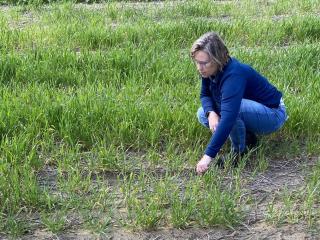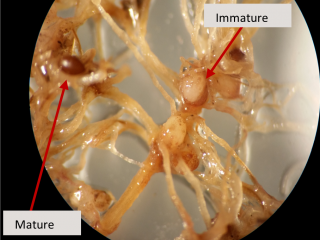Cereal cyst nematodes
- Geraldton port zone

This year cereal crops in the Geraldton port zone are displaying noticeable signs of infestation by cereal cyst nematodes (Heterodera avenae; CCN). Additionally, most of the soil samples from Western Australia submitted to the South Australian Research and Development Institute (SARDI) PreDictaB or the Department of Primary Industries and Regional Development (DPIRD) Diagnostic Laboratory Services (DDLS) this year, which showed the presence of CCN, came from the Geraldton port zone.
CCN is one of the most damaging soilborne pests for oats, wheat and barley. Symptoms can easily be confused with nutrient deficiency, but inspection of washed roots can show if CCN is the cause. If CCN is present in a paddock and it is not managed, then there is a risk that levels will become high and cause yield losses of up to 70% in wheat, 90% in oats and 50% in barley.
CCN are microscopic worm-like creatures that invade the plant roots as juveniles where they set up a fixed feeding site. They have one generation per season. They survive over summer as eggs in a cyst with 60 to 80% of the eggs hatching during the winter growing season. The eggs need a period of cold, < 15°C, and moisture to hatch. Hatching rates are reduced during drought.
As CCN invade roots and affect the plants’ ability to take up nutrients and water, symptoms of paddock infestation can be more noticeable in dry seasons where a healthy root system is paramount.
So far, CCN distribution in WA has been restricted to the northern growing areas of the Geraldton port zone, some central growing regions including Moora, areas near Wongan Hills and Yerecoin, the Avon valley and near Esperance. There have also been sporadic instances reported in Albany.
Symptoms of cereal cyst nematodes

Above ground visible symptoms of CCN infected plants include stunting, patchy poor growth, yellowing (particularly at the stem tips) and a tendency to wilt despite adequate soil moisture. Later in the season, patches may be less distinct but infested plants usually will have less tillers, little or no grain fill and hay off early due to compromised root systems. Above ground symptoms of CCN are often hard to detect until levels are high enough to significantly impact yields.


Below ground symptoms manifest as thickened, shortened roots with distinct ‘knots’ and a lot of small lateral roots compared to healthy plants. In spring, the adult female becomes visible as a white ‘swelling’ on the root. This swelling is the body of the female and is full of eggs. Later in the season, the female dies and the outer membrane of her body hardens into a brown cyst which protects the eggs over summer. The cyst is about the size of a pinhead and can be seen with the naked eye as a white ‘pearl’ or brown cyst.
Diagnosis
For diagnosis of nematode problems in-crop, you can carefully dig up symptomatic plants from the edge of the patch (not the centre) as well as healthy plants from outside the patches. DPIRD’s YouTube video how to take a plant sample shows the correct method to use.
Plants can be sent to the DPIRD Diagnostic Laboratory Services by mailing them to:
Department of Primary Industries and Regional Development
Reply Paid 83377
3 Baron-Hay Court
South Perth WA 6151
Management
If a paddock has CCN it is important to monitor levels regularly and grow resistant crops or resistant cereal varieties if levels start to increase. Resistant wheat, barley and oat varieties are available. This nematode only feeds on grasses so rotation with non-cereal crops like canola and lupins are great management options for CCN infested paddocks. In cases of high infestation levels, two consecutive years of growing resistant crops or varieties may be necessary to reduce levels that don’t impact cereal yields. Refer to DPIRD’s 2023 WA Crop Sowing Guide for nematode resistance classifications for different varieties.
Growers are strongly encouraged to identify CCN presence on their properties and exercise caution to prevent its spread between properties.
More information
To read about prior nematode activity this season refer to the 2023 PestFacts WA Issue 16 article Why is my crop patchy? Diagnose soilborne disease to form strategies for next season.
For more information refer to DPIRD’s Diagnosing cereal cyst nematode page.
For more information contact Senior Nematologist Sarah Collins in South Perth on +61 (0)8 9368 3612 or Research Officer Carla Wilkinson in South Perth on +61 (0)8 9368 3862.
Article authors: Sarah Collins (DPIRD South Perth), Carla Wilkinson (DPIRD South Perth) and Cindy Webster (DPIRD Narrogin).
